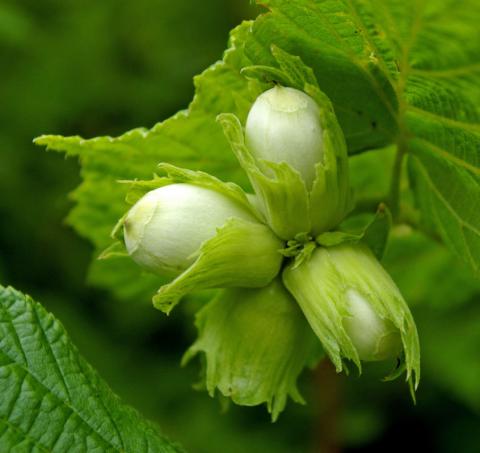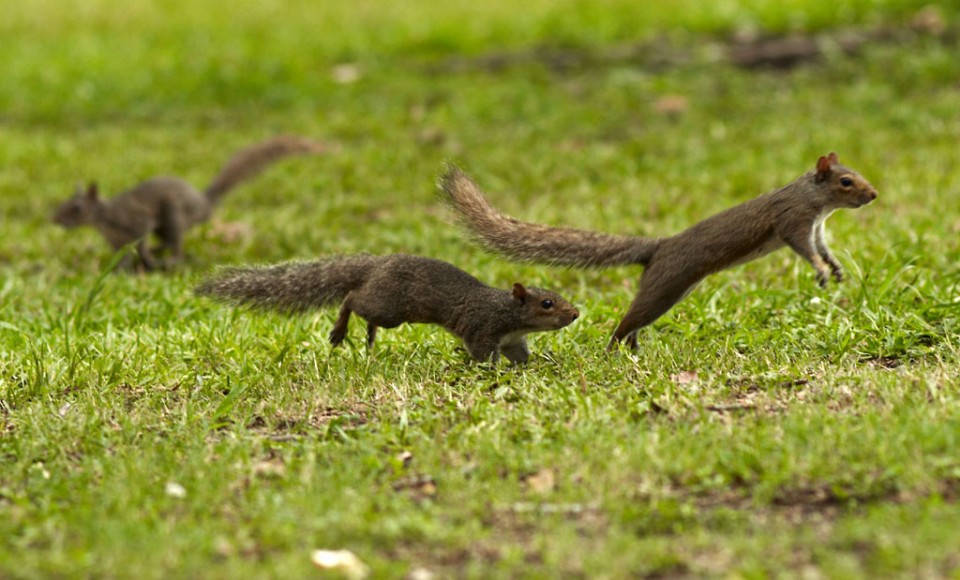Squirrel Territory & Home Range
In order to survive from one year to the next, an animal must obtain certain things. It must find enough food and water, sufficient shelter and, in most cases, also find a mate. How readily available these resources are determines how far an animal must travel to find them. An industrial estate may, for example, provide fewer foraging opportunities than a pine forest or mature deciduous woodland and a squirrel living there may need to travel further to find all the food it needs.
The rodent ranger
Home range is defined as the area over which individuals or groups move during their day-to-day activities and, as such, will vary in size according to how dispersed these resources are – in essence, it’s the area in which a given animal lives and commutes around. Part of this area may be shared with other individuals of the same species, while another part is defended against intrusion (a territory). Humans, for example, share streets, parks and restaurants with other people, but are generally much more defensive of their house. The area over which you move on a daily, weekly, monthly, etc. basis while walking the dog, going out for a meal, meeting friends, etc. would be your home range, while your house and garden are your territory. Squirrels, too, will defend a ‘core area’ from intruders, while tolerating other individuals in nearby areas in which they also forage, such as gardens with feeding stations.

Squirrels are known to range over a large area, the size of which varies according to season and habitat type. In British hardwoods forests, for example, Grey squirrels tend to range over between two and ten hectares (i.e. 25 to 125 home ranges in a square mile) for most of the year in productive woodlands with a stable mast crop, but males may cover more than 100 ha (one sq-km or just under half sq-mile) while searching for females during the mating season. Red squirrels have similar sized home ranges -- typically between two and ten hectares, average of seven hectares (17 acres) -- although about one hectare of this range is intensively used (referred to as a “core area”) and does not overlap with those of other squirrels. In conifer plantations, where seed crops fluctuate, Red ranges are much larger: 10 to 50 ha (i.e. as few as five ranges in a square mile).
The overall range size of Reds in the deciduous woodlands of Northern Belgium is almost double that of Reds inhabiting coniferous forests in the same region. Studies following radio-tagged Red squirrels have shown that, while the range size for males during the spring breeding season increased only marginally in deciduous woodlands, there was a two-fold increase in conifer habitats. Squirrels may use smaller areas during years of high mast crop, because they don’t need to travel as far to find all the food they need, and may expand their range in poor mast years. Indeed, tracking data suggest that a squirrel’s range may increase five-fold when a bumper mast year is followed by a poor seed crop.
Males tend to range over larger areas than females, although females maintain more stable ranges and juveniles tend to range less than adults. Range size may also depend on social status. On the Isle of Wight, for example, squirrel biologist Jessica Holm found that the ranges of dominant Reds were smaller than those of subordinates – Holm suggested that this reflects the ability of dominant individuals to hold-down the choice spots, with the most food, in a habitat. Studies from the continent have provided conflicting data, however, with dominant male Reds in Belgium and Italy having larger ranges than subordinates. In addition, data collected by Luc Wauters and Andre Dhondt show that subordinate Red squirrels behave as “floaters” (i.e. had no fixed territory) or settled on the edges of the ranges of dominant females. Indeed, all sub-adult Red squirrels in one study spent their first winter as low-ranked floaters or on the periphery of home ranges maintained by dominant adults.
All change
Territory shifts, where an individual will relocate to a new territory from an established one, have been observed in squirrels, although they appear to be rare. Work by Belgian biologists published in the journal Animal Behaviour during 1995 showed that, of the 44 female Red squirrels in their study area, seven (16%) vacated the territory on which they first settled in favour of adjacent, vacant spots during the eight-year study. The researchers found that females from territories with poor resources were more likely to move, if they could find a better area. Active bequest of territory to offspring was not observed and females that switched increased their reproductive rate on the new territory.
Ultimately, the biologists found that switching of territory was an adaptive phenomenon, occurring in response to poor breeding conditions. Indeed, work by Luc Wauters and Luc Lens at Antwerp University in Belgium has demonstrated that female Red squirrels in poor territories have reduced fecundity or suffered breeding failure (e.g. failure to wean litters, high kitten mortality, etc.) compared to conspecifics in good territories. In other words, a squirrel must secure a decent territory if it has any chance of breeding successfully.

There are reports of mass migrations of both Red and Grey squirrels in response to seed crop failures. Following successive ‘good years’ a squirrel population increases to the carrying capacity of the habitat. If there is a subsequent poor mast year, there is insufficient food to support all the squirrels and they must either leave or starve. Reports from Russia in the 1930s and 40s describe enormous migrations of Red squirrels on the move, even swimming fast-flowing rivers such as the Amur, Ob and Yenesi or large bodies of water including Lake Baikal and the Gulf of Finland.
In Squirrels in Britain, Keith Laidler notes that the migrating squirrels “move in a long ‘skirmishing line, sometimes more than thirty-five miles [56 km] in extent”, are virtually impossible to stop once the migration has started, and tells of a hoard of black and grey squirrels swimming five miles (8 km) across Seneca Lake in New York state during 1848. According to Laidler, the migration ‘wave’ moves at about a mile and a half (2.4 km) per day. More recently, a large group of Greys were observed swimming across the Potomac River near Washington D.C. in the autumn of 1990. I’m not aware of any similar migrations having occurred in Britain.
Good fences…
Territory boundaries are marked with scent. Scent, in the form of urine, faeces and glandular secretions from apocrine glands situated around the mouth (‘cheek glands’), is deposited on routes throughout the home range, particularly on tree trunks and branches, and is maintained by the territory owner. Both species will rub their cheeks on, and drag their anus over, branches to deposit the scent. (See Scent-marking)